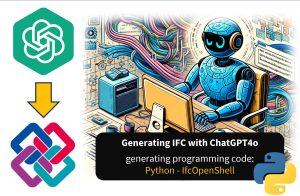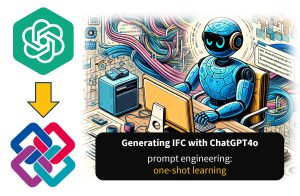ISO-10303-21; HEADER; FILE_DESCRIPTION ((”), ‘2;1’); FILE_NAME (‘Bridge model example’, ‘2024-10-14T17:42:13’, ‘Kamil Korus’, ‘AECO Evolution’, ‘Processor version’, ‘Software’, ”); FILE_SCHEMA ((‘IFC4X3_ADD2’)); ENDSEC; DATA; #1=IFCPROJECT(‘0vGCH5MKb7IxXhcP$Yz3$a’,$,’Bridge project’, ‘This project is a simple example of modeling a bridge’,$,$,$,(#14,#17),#2); #2=IFCUNITASSIGNMENT((#3,#4,#5,#6,#7,#8,#9,#10,#11)); #3=IFCSIUNIT(*,.LENGTHUNIT.,.MILLI.,.METRE.);#4=IFCSIUNIT(*,.AREAUNIT.,$,.SQUARE_METRE.);#5=IFCSIUNIT(*,.VOLUMEUNIT.,$,.CUBIC_METRE.); #6=IFCSIUNIT(*,.SOLIDANGLEUNIT.,$,.STERADIAN.);#7=IFCSIUNIT(*,.PLANEANGLEUNIT.,$,.RADIAN.); #8=IFCSIUNIT(*,.MASSUNIT.,$,.GRAM.); #9=IFCSIUNIT(*,.TIMEUNIT.,$,.SECOND.); #10=IFCSIUNIT(*,.THERMODYNAMICTEMPERATUREUNIT.,$,.DEGREE_CELSIUS.); #11=IFCSIUNIT(*,.LUMINOUSINTENSITYUNIT.,$,.LUMEN.); #12=IFCCARTESIANPOINT((0.,0.,0.));#13=IFCAXIS2PLACEMENT3D(#12,$,$);#14=IFCGEOMETRICREPRESENTATIONCONTEXT($,’Model’,3,1.E-05,#13,$); #15=IFCCARTESIANPOINT((0.,0.));#16=IFCAXIS2PLACEMENT2D(#15,$);#17=IFCGEOMETRICREPRESENTATIONCONTEXT($,’Plan’,2,1.E-05,#16,$); #18=IFCLOCALPLACEMENT($,#13);#19=IFCDIRECTION((1.,0.,0.));#20=IFCDIRECTION((0.,1.,0.));#21=IFCDIRECTION((0.,0.,1.)); #22=IFCFACILITY(‘3eRo4UYs96VvgzHYlN5rwP’,$,’Facility’,$,$,$,$,$,$);#23=IFCRELAGGREGATES(‘1zjaZZpoz2EwQTKxCE3dQj’,$,$,$,#1,(#22)); #24=IFCBRIDGE(‘2pyXrKuJX2hROBEU2KQ1rq’,$,’Bridge’,$,$,$,$,$,$,.GIRDER.);#25=IFCRELCONTAINEDINSPATIALSTRUCTURE(‘2PeVAh2uH2phENraW6lvHj’,$,$,$,(#24),#22); #26=IFCBRIDGEPART(‘2N8pyojwb4Bgw07KZBEF3O’,$,’Superstructure’,$,$,#36,#55,$,$,.USERDEFINED.,.SUPERSTRUCTURE.);#27=IFCRELCONTAINEDINSPATIALSTRUCTURE(‘1LqnXVBdfEMwYGj9_UUshh’,$,$,$,(#26,#30),#24); #28=IFCMATERIAL(‘Concrete’,$,$);#29=IFCRELASSOCIATESMATERIAL(‘295_zxIQT9QBPS_FCpe59Y’,$,$,$,(#26),#28); #30=IFCALIGNMENT(‘2eDu6iXCn6qfh2qIv8t0P2’,$,$,$,$,#18,#35,$);#31=IFCPOLYLINE((#32,#33));#32=IFCCARTESIANPOINT((0.,0.,0.));#33=IFCCARTESIANPOINT((20000.,0.,400.));#34=IFCSHAPEREPRESENTATION(#14,$,’Curve3D’,(#31));#35=IFCPRODUCTDEFINITIONSHAPE(‘Alignment shape definition’,$,(#34)); #39=IFCARBITRARYCLOSEDPROFILEDEF(.AREA.,$,#40);#40=IFCPOLYLINE((#41,#42,#43,#44,#45,#46,#47,#48,#49,#50,#51,#41));#41=IFCCARTESIANPOINT((0.,0.));#42=IFCCARTESIANPOINT((-3800.,-76.));#43=IFCCARTESIANPOINT((-6750.,-17.));#44=IFCCARTESIANPOINT((-6750.,-237.));#45=IFCCARTESIANPOINT((-4300.,-356.));#46=IFCCARTESIANPOINT((-3900.,-1100.));#47=IFCCARTESIANPOINT((3900.,-1100.));#48=IFCCARTESIANPOINT((4300.,-356.));#49=IFCCARTESIANPOINT((6750.,-237.));#50=IFCCARTESIANPOINT((6750.,-17.));#51=IFCCARTESIANPOINT((3800.,-76.)); #53=IFCFIXEDREFERENCESWEPTAREASOLID(#39,$,#31,$,$,$);#54=IFCSHAPEREPRESENTATION(#14,’Body’,’SolidModel’,(#53));#55=IFCPRODUCTDEFINITIONSHAPE(‘Superstructure shape definition’,$,(#54)); #56=IFCPERFORMANCEHISTORY(‘2AKe$ZJ1bCxunXTKWapVSF’,$,‘Superstructure





